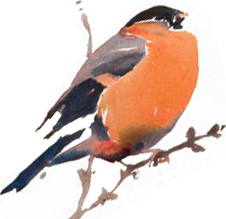Lots of people over millennia have wondered what it might be like to be a bird, especially what it might be like to be able to fly. But of course there’s much more to birds than flying, and throughout my younger life I had often thought about what it would be like to see like an eagle, or to feel like a Woodcock.
As a scientist, I have been incredibly lucky to have studied a wide range of different bird species, including Buffalo Weavers in Africa, Zebra Finches in Australia, Grey Herons in Yorkshire and Aquatic Warblers in Poland. But I have spent more time studying Common Guillemots – in the Arctic and on Skomer Island, Wales – than any other species. Less instantly charismatic, colourful or comical than Puffins, Guillemots have a much more interesting and sophisticated social life. Packed in together like sardines at their breeding colonies, Guillemots depend on each other to keep their eggs and chicks safe from predatory gulls and corvids.

I have studied Guillemots for 49 years and the more I watch them the more I realise just how special are their senses. Once, while I was in a hide, I watched as an incubating female stood up and started to utter a typical guttural greeting call… but, without her partner. Then, as I looked far out over the waves, I could see a mere speck of a bird flying in towards the colony, and to my amazement it landed beside the calling female. At that moment, I realised that the female had recognized her partner from some incredible distance and in a flash my entire appreciation of Guillemots changed; I had underestimated them. Perhaps I had underestimated all other bird species too – their eyesight, their hearing, their sense of touch, taste and most intriguingly of all, their ability to experience emotions.
It was a landmark moment in my ornithological life, forcing me to start reading about the senses of birds. In a way this was forbidden territory, at least for me as a behavioural ecologist. Although many researchers over the years had investigated the senses of birds, it did not seem to be a mainstream topic.

I quickly realized that writing a book covering the various aspects of how birds perceive their world – whether it was a Kiwi, Kestrel or Kakapo – was what I needed to do, and in due course Bird Sense was published in 2012. I also realized that by demonstrating just how remarkable and under-valued the senses of birds are, I might help people to appreciate birds more and, as a result, be more likely to want to help protect them.
It was my agent, the late Felicity Bryan, who suggested that Bird Sense could be rewritten as a children’s book. Working again with Bloomsbury, they took on award-winning artist Catherine Rayner to produce some stunning illustrations. All (!) I had to do was to write in a way that 7-10 year olds would find interesting and understandable. Having had three children of my own (long-since fledged) and the prospect of soon becoming a grandparent, I was excited at the idea of writing What it’s like to be a bird. Many of my ex-PhD students and post-docs had children of the right age and they (or their parents) kindly agreed to look at what I’d written and comment on the language and vocabulary.

I chose birds I was familiar with and whose lifestyle meant that they relied on particular senses. For smell, it was Albatrosses and Honeyguides. For touch, it was Guillemots (all that allopreening). For hearing, it was the extraordinary Great Grey Owl. For echolocation, it was Oilbirds that I had seen several times in South America. The magnetic sense featured the European Robin (seeing the earth’s magnetic field through one eye!). For plain but extraordinary vision, it had to be the Peregrine. For taste, it was ducks (with taste buds in the roof of the mouth). And for a sense of fun, it had to be corvids, since I had often watched Magpies tobogganing in the snow.
The future of birds, and of our planet depends on the next few generations. If What It’s like to be a Bird inspires even an handful of young people to become bird enthusiasts or professional ornithologists, I shall be delighted.
Tim Birkhead
Tim's book is available from our HQ shop in Aberlady, priced £12.99
Illustrations by Catherine Rayner, text by Tim Birkhead, photographed in What it's Like to be a Bird with kind permission to share from Bloomsbury Publishing




